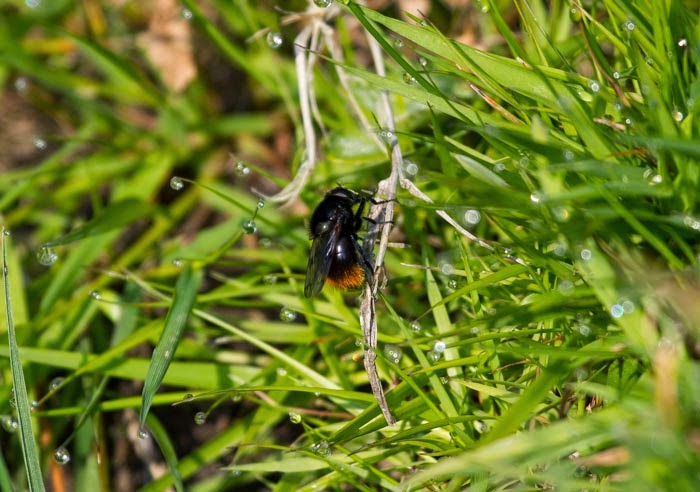Sarah, Tobias and I spent a chilled weekend in a sun drenched Cornwall staying at our cottage just to the west of St. Ives at Trowan. I love the stretch of coastline between St.Ives and St. Just, it is perhaps one of the most unspoilt stretches of coastline in the UK being dominated by moorland and low intensity agriculture dominated by cattle grazing. The National Trust owns much of the coastal strip which is dominated by coastal heath. Much of the weekend was spent relaxing but I did sneak out for some early morning birdwatching before Sarah and Tobias awoke.
On Saturday morning I visited Kenidjack and strolled through the valley to the coast. It was generally fairly quiet, as was expected at this time of the year. At the bottom of the valley is a deep cleft in the cliff face known as 'Zawn Buzz and Gen' roughly translated to gully of food and song. I often sit on the cliff top here and stare into the gully. There are Herring Gull nesting in the Gully and it is a good place to stare right into their nests. As I climbed the cliff slope to the cliff top I heard the distinctive 'chow' of Chough and four birds tumbled from the east and landed on the cliff top a few metres away. All birds were colour ringed and part of the
Cornish Chough reintroduction project.
Chough - Kenidjack
Herrign Gull with chicks - Zawn Buzz and Gen, Kenidjack
The Herring Gulls in Zawn Buzz and Gen had well grown chicks all of a similar age, interestingly those seen at the same time on the roof tops of St. Ives had far more advanced chicks with juvenile feathers and only a few days off flying. I wondered whether this was down to diet of the St. Ives birds being higher in the fat of chips and ice-creams allowing a faster development?
Grey Heron - Kenidjack
Four Grey Heron flew east along the coast spooking the local Herring Gulls. On the beach at the mouth of Kenidjack was the usual gathering of rather motley looking immature and sub-adult Herring Gulls.
3rd Summer and 1st Summer Herring Gulls - Kenidjack
1st and 2nd summer herring Gulls - Kenidjack
As I walked back up the valley a loud 'woosh' overhead and a Peregrine appeared chasing a Collared Dove. The Collard Dove dived into a bush 20 metres in front of me and the Peregrine made a sharp turn to pull out of the dive and circled briefly overhead. My photos show that this bird was ringed although it is not possible to read the ring number from the shots.
Peregrine - Kenidjack
Other birds seen included four Red Kite circling over St. Just seen from the top of the valley these birds headed east and I later saw them a few miles east circling over the Gurnards Head pub. Numerous Manx Shearwater were present offshore, mainly moving west, and in a half hour of scanning I recorded approximately 250 birds without trying. The nearest breeding colonies are on the Pembrokeshire Islands of Skomer and Skokholm but it is thought that the birds seen offshore in Cornwall during the summer are non-breeding birds, breeders from these colonies heading into the
Irish Sea to feed.
A Small Pearl-bordered Fritillary was nice to see at the top of the valley, this is not a species I see often in Hampshire.
Small Pearl-bordered Frittillary - Kenidjack
On Sunday I did a short, but hot and strenuous, walk from the cottage to the coast nearby and walked from Hellesveor Cliff east to Pen Enys Point. Other than the large numbers of Manx Shearwater offshore the only birds of note were a pair of Shelduck that appeared to be prospecting for a nest site at Pen Enys Point, this was my first record of the species for this location.
Pair of Sheduck - Pen Enys Point
Two species of bumblebee mimic hoverfly were seen, the White-tailed Bumblebee mimic, Volucella bombylans and the Red-tailed Bumblebee mimic, Merodon equestris. And, one of my favourite British hoverflies the wasp mimic Chrysotoxum verralli was seen at Hellesveor Cliffs.
Volucella bombylans - Pen Enys Point
Merodon equestris - Pen Enys Point
Chrysotoxum verralli - Hellesveor Cliffs
There was an abundance of orchids in flower with Heath Spotted-orched and many Early Marsh-orchid, the latter ranging in colour from white to a dark pink.
Early Marsh-orchid - Cliffs between Hellesveor Cliff and Pen Enys Point
Much of the rest of the weekend was spent relaxing and catching up with friends including an enjoyable afternoon on the beach at Sennen with world famous birder Nigel Wheatley his partner Alice and sons Ned and Tom.
World famous birder pretending not to sunbath




















































